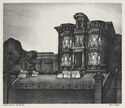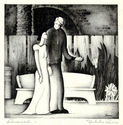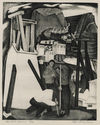
19th, 20th & 21st Century Fine Prints
707-546-7352 · fax 707-546-7924 · web: www.annexgalleries.com · email: artannex@aol.com
WPA-FAP Prints from Northern California - Introduction
Artistic communities of the 1930s were hit hard by the Great Depression. Galleries closed, museums had no funds, and patronage disappeared. President Franklin Delano Roosevelt launched his ambitious Works Progress Administration (WPA) programs that sent millions of unemployed Americans back to work building and repairing much of the country’s infrastructure including dams, bridges, and college buildings.
Painter/printmaker George Biddle is credited with convincing President Roosevelt, his old college roommate, to also create a “New Deal” program for the Arts. Several programs resulted including the Public Works of Art Program (PWAP), the Treasury Section of Fine Arts (The Section), the Treasury Relief Art Project (TRAP) and the better known, broad-based WPA-FAP (Federal Art Project), which, at its peak, employed five thousand artists.
The WPA-FAP was broken into various divisions within each state and included Mural Painting, Easel Painting, Graphic Arts, Sculpture, and Education. The works created in these divisions were created for or utilized by public facilities such as government buildings, post offices, schools, hospitals, and military bases. The mandate of the WPA-FAP was employment, not the “higher” purpose of creating a great work of art. The early political climate of the PWAP demanded a distinct “American” style, free of other influences. This policy was reluctantly accepted and constantly challenged, leading to much controversy and many policy changes.
Under Director Holger Cahill, the Graphic Arts division of the FAP had much more freedom than did the other divisions. For many artists this was the first time they did not need to concern themselves with critical or financial success. Many were able to explore and experiment with the various printmaking media, despite bureaucratic limitations, particularly in the areas of color printmaking. In New York Russell Limbach consulted for lithography and Louis Schanker for color woodcut.
It was in the WPA-FAP that screen-printing became accepted as a Fine Art medium. The inexpensive equipment that was required for screen-printing enabled many more artists to directly participate rather than needing the large presses and skill that were required to print intaglios and lithographs. Anthony Velonis, among others, had worked as a commercial silkscreener and taught the craft to interested artists. In Philadelphia, African-American printmaker Dox Thrash and co-workers developed the carborundum print and, in California, WPA printer Ray Bertrand developed a new transfer paper for lithography which enabled artists from around the state to send him their drawings by mail. Bertrand would transfer them to a litho plate and prove them.
Stylistically the WPA-FAP graphic artists tended to fall into two camps, Realists and Modernists. The Realists were by far predominant, working for the bureaucracy in the “American” style that was easily understood and expected. These artists were divided into two groups, the first was the “American Scene,” which was generally rural in nature and tended to glorify the American worker and the landscape with an apolitical and optimistic view. In contrast, the second group “Social Realism” was urban and political in nature, often depicting the poverty, crime, graft and exploitation so common in the cities during the Depression. The Modernists were in the minority and also fell into camps regarding degrees of abstraction and other experimental imagery. What they had in common was an unwillingness to shrug off the influences of Europe such as Cubism, Surrealism, and Expressionism. Indeed, many of the artists working in the urban environs had been active artists in Europe, coming to America in the late 1920s and early 1930s to escape the depression there. The project offered opportunities to a diverse group of artists that also included immigrants from Russia, China, Japan, and other countries. In the WPA-FAP they were put together with both young and experienced American artists that included women, Hispanic, and African-Americans and a dialog began that would change American printmaking forever.
Though some two hundred thousand prints were produced from some eleven thousand original matrices much of this work has disappeared. Although these works were supposed to have been given to American museums and libraries many were destroyed when the U.S. entered World War II. Their fate was to be pulped for the war effort or tossed away by zealous curators who did not want to be reminded of the Depression. Many were lost to general indifference as most museums and libraries could not afford the space to house or the staff to catalogue them. Since the prints were not meant to be sold, they were generally not found in private collections. The small editions (usually twenty-five or fewer) have made them scarce.
Please click on the link below to take you to the exhibition. PLEASE NOTE: these works often have labels attached to the verso or other physical issues, which the prices generally reflect. However, these prints are RARE and finding any in "perfect" condition is nearly impossible, though for the most part these can be restored. Contact us with any condition inquiries.









